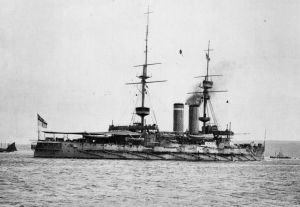Duncan class battleship
|
|
The Duncan class battleships were pre-Dreadnought battleships of the Royal Navy. They had a higher speed, but the same armament and a smaller displacement compared to their similar predecessor, the Majestic class. To compensate this, the Duncans had far less armour, which could potentially be deadly in an engagement. They were designed to be fast battleships in response to new warship designs of the Russian and French Navies. The ships of the class were named after famous Admirals of the Royal Navy, the lead ship being named after Adam Duncan, 1st Viscount Duncan of Camperdown.
All six ships were launched in 1901. One ship, Montagu, was lost prematurely due to her running aground in heavy fog on Lundy Island in 1906. She was broken up where she lay. The Duncans effectively became obsolete, as with every other battleship of the Royal Navy, indeed of every other Navy in the world, when the Dreadnought was commissioned in 1906.
Ships
- Albemarle was badly damaged in 1915 in heavy weather while in the Pentland Firth. Then used as an ice breaker and overflow ship before being broken up in 1919.
- Cornwallis was the first ship to fire her guns during the ill-fated Dardanelles Campaign in 1915. She took part in all operations including the Gallipoli evacuation. She was sunk in January 1917, after being hit by three torpedoes from U-32 off Malta, with the loss of fifteen lives.
- Duncan served for much of her career in the Mediterranean. Was a gunnery tender ship at Portsmouth before joining the 2nd Battle Squadron, then transferring to the 3rd Battle Squadron. She was placed in Reserve in 1917 and broken up in 1920.
- Exmouth was a gunnery tender at Portsmouth in 1913 before joining the 6th Battle Squadron. She was later on allocated to the 3rd Battle Squadron. In 1914, she was a vital cog in the reform of the Channel Fleet, along with other pre-Dreadnoughts of the Formidable and Lord Nelson classes. She was in action during the Zeebrugge bombardment in 1915 and was involved in the Dardanelles campaign. She was placed in reserve in 1917 and broken up in 1920.
- Montagu was wrecked after running aground on Lundy Island on 30 May 1906.
- Russell - She joined the Channel Fleet in 1914. She took part in the bombardment of Zeebrugge, and was also involved in the Dardanelles campaign, taking part later on, in the evacuation of Gallipoli. On the 27th April 1916 she was mined off the coast of Malta, with the loss of over 100 lives.
Characteristics
- Displacement: 14,000 tons
- Length: 432ft
- Beam: 75ft
- Draught: 25ft
- Armament: 4 x 12-inch guns, 12 6-inch QF guns, 12 x 3-inch guns, 4 x 18-inch torpedo tubes. Some sources state 12 pdr QF instead of the 3-inch and add 6 x 3-pdf QF.
- Complement: 720
- Speed: 19 knots
- Propulsion: Water tube boilers, 2 x vertical triple expansion, 18,000hp, 2 shafts

